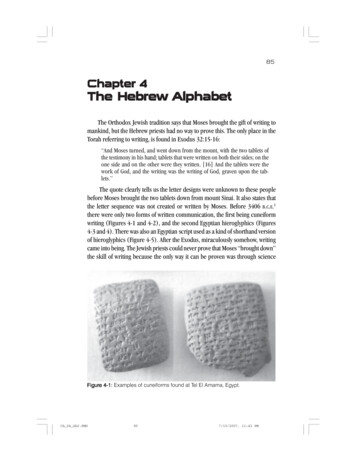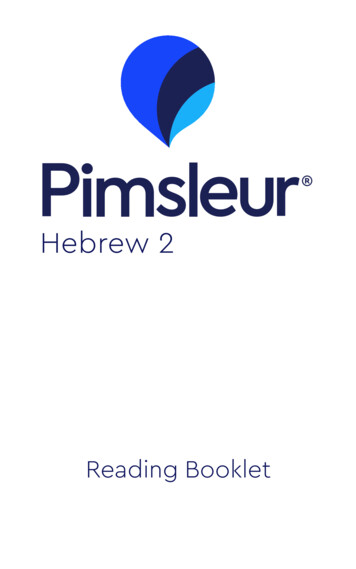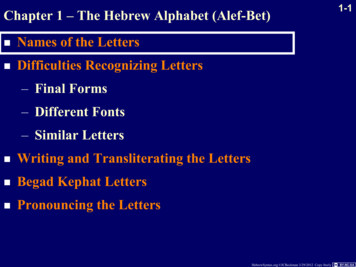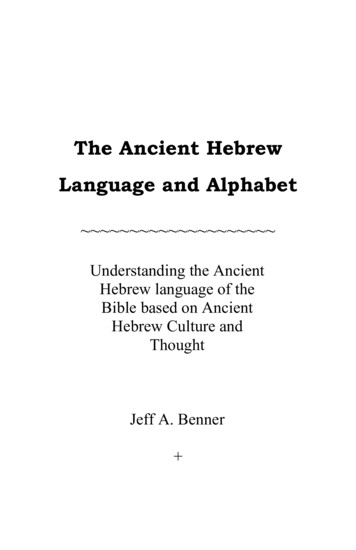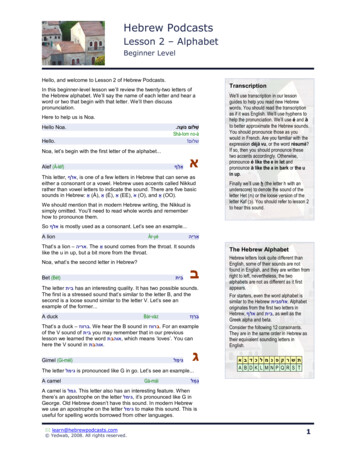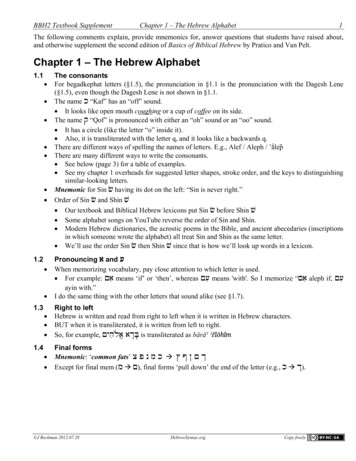
Transcription
BBH2 Textbook SupplementChapter 1 – The Hebrew Alphabet1The following comments explain, provide mnemonics for, answer questions that students have raised about,and otherwise supplement the second edition of Basics of Biblical Hebrew by Pratico and Van Pelt.Chapter 1 – The Hebrew Alphabet1.1 Pronouncing א and ע When memorizing vocabulary, pay close attention to which letter is used. For example: ִאם eans ‘if or ‘then whereas ִעם means 'with'. So Ia in with.”I do the same thing with the other letters that sound alike (see §1.7). Right to leftHebrew is written and read from right to left when it is written in Hebrew characters.BUT when it is transliterated, it is written from left to right.So, for example, ֱֹלהים ִ בָּ ָּרא א is transliterated as bārāōhîm Final formsMnemonic: ‘common fats כ מ נ פ צ ך ם ן ף ץ Except for final mem ( מ )ם final for s ‘pull down the end of the letter (e. . כ )ך .1.2 1.3The consonantsFor begadkephat letters (§1.5), the pronunciation in §1.1 is the pronunciation with the Dagesh Lene(§1.5), even though the Dagesh Lene is not shown in §1.1.The name “ כ Kaf” has an “off” sound. It looks like open mouth coughing or a cup of coffee on its side.The name “ ק Qof” is pronounced with either an “oh” sound or an “oo” sound. It has a circle (like the letter “o” inside it). Also, it is transliterated with the letter q, and it looks like a backwards q.here are different wa s of spellin the na es of letters. . . lef lephleˉThere are many different ways to write the consonants. See below (page 3) for a table of examples. See my chapter 1 overheads for suggested letter shapes, stroke order, and the keys to distinguishingsimilar-looking letters.Mnemonic for Sin ׂש having its dot on the left: “Sin is never ri ht.”Order of Sin ׂש and Shin ׁש Our textbook and Biblical Hebrew lexicons put Sin ׂש before Shin ׁש Some alphabet songs on YouTube reverse the order of Sin and Shin. Modern Hebrew dictionaries, the acrostic poems in the Bible, and ancient abecedaries (inscriptionsin which someone wrote the alphabet) all treat Sin and Shin as the same letter. We ll use the order Sin ׂש then Shin ׁש since that is how we ll look up words in a lexicon.1.4 J Beckman 2012.07.28HebrewSyntax.orge orize “ ִאם aleph if, ִעם Copy freely
21.5Chapter 1 – The Hebrew Alphabet 1.6 1.7 1.8 1.9 1.10 BBH2 Textbook SupplementBegadkephat lettersThe da esh in a be ad kephat indicates the kind of sound that ou can t prolon (e. . P ) Begad kephat letters without a dagesh have the kind of sound you can prolong (e.g., F )Note that for begadkephat letters, there is either a dot in the Hebrew letter or a line in thetransliteration.Mnemonic: Dagesh is a dot, which is a visual representation of a momentary sound (e.g., P ).Mnemonic: Begad kephat letters without a dagesh have a line in transliteration, which is a visualrepresentation of a sound that can go on for a long time (e.g., F )The line used to transliterate begadkephat letters without a Dagesh Lene goes under the letter ( b d k t )except for the letters where an underline wouldn t fit, in which case an over-line is used ( gˉ pˉ ).When something is added on to a word or the word is otherwise changed (e.g., dog dogs, do does did), the Dagesh Lene may appear or disappear. A Dagesh Lene just indicates the pronunciation ofthe particular form of a word.Final kaf ( ) ך is usually written with two dots in it ( ) ְך , to distinguish it from a final nun ( ) ן . Thosedots are a shewa (see §2.11), not a Dagesh Lene. Pronounce final kaf with the shewa ( ) ְך as כ , like thech in Bach.Advanced information: Modern Hebrew uses a hard pronunciation for ג ד ת , regardless of whether ornot they have a dagesh in them. I do too.GutturalsResh ( ) ר is NOT a guttural letter. It is never a guttural letter.Resh behaves in some of the same ways as a guttural letter, as you will learn in later chapters.In case you are curious: Since Kaf without a Dagesh Lene ( ) כ is pronounced ust like et ( ) ח ,which is a uttural letter ou i ht wonder wh et is uttural but Kaf isn t. he reason is a historicalone: Kaf used to always be pronounced with the hard K sound, and it developed the CH sound later on,when the sound rules that change the pronunciation in the presence of a guttural were no longeraffecting new words.Easily confused lettersThere are other letters that sound alike: ( א Alef) and ( ע Ayin), and ( כ Kaf) and ( ח et)I recommend distinguishing all letters orally when memorizing vocabulary. See my comment on §1.2.When writing the letters, be sure to make it clear which letter you are writing.TransliterationThere are multiple systems of transliterating Hebrew, so if you want to know the exact spelling, youwill need to check the details of the system that is used in the particular book or journal article.Fortunately, if you learn the basic system presented in this textbook, you will usually be able torecognize what word or words is being transliterated, assuming that you know the word in Hebrew.Numerical ValuesAdvanced information: For numbers from 1–999 a dot is put over the letter (e.g., א 1, ב 2). For numbers from 1000–9999, two dots are used (e.g., א 1000, ב 2000).These numbers are never used within the text of the Bible. They are only used for notes in the margin.Within the Biblical text nu bers are alwa s written out (like ‘one instead of 1).Final KafWhen final kaf ( )ך appears with two dots ( )ְך , those dots are a Silent Shewa (§3.6.1.c).A final kaf with a Silent Shewa ( )ְך does not have a Dagesh Lene, so it is pronounced ch like Bach.Copy freelyHebrewSyntax.org2012.07.28 J Beckman
BBH2 Textbook Supplement Chapter 1 – The Hebrew Alphabet3When writin Hebrew b hand don t tr to i itate all the details of the fanc letter shapes used in books.Instead, use a simpler style like that used in the Arial and Choco fonts, below. My overheads for chapter 1 show the suggested stroke order and how to distinguish similar letters.Alternately, your teacher may permit you to use the modern style of handwriting that is used in Israel. Notice that some modern-style handwritten letters look quite different from those printed in books.ModernPrinted in booksImitate thisHandwritingSBLTimes NewEzra SILHebrewRomanArialChocoYoav Aleph א א א א א א Bet ב ב ב ב ב ב Bet Dagesh ב ּב ּב ּב ּב ּב Gimel ג ג ג ג ג ג Gimel Dagesh ּג ּג ּג ּג ּג ּג Dalet ד ד ד ד ד ד Dalet Dagesh ּד ּד ּד ּד ּד ּד He ה ה ה ה ה ה Waw ו ו ו ו ו ו Zayin ז ז ז ז ז ז et ח ח ח ח ח ח Tet ט ט ט ט ט ט Yod י י י י י י Kaf כ כ כ כ כ כ Kaf Dagesh ּכ ּכ ּכ ּכ ּכ ּכ Kaf (final) ך ך ך ך ך ך Kaf (final withsilent shewa) ְך ְך ְך ְך ך ְְ ך J Beckman 2012.07.28HebrewSyntax.orgCopy freely
4Chapter 1 – The Hebrew AlphabetPrinted in booksSBLTimes NewEzra SILHebrewRomanBBH2 Textbook SupplementModernHandwritingImitate thisArialChocoYoavLamed ל ל ל ל ל ל Mem מ מ מ מ מ מ Mem (final) ם ם ם ם ם ם Nun נ נ נ נ נ נ Nun (final) ן ן ן ן ן ן Samek ס ס ס ס ס ס Ayin ע ע ע ע ע ע Pe פ פ פ פ פ פ Pe Dagesh ּפ ּפ ּפ ּפ ּפ ּפ Pe (final) ף ף ף ף ף ף Tsade צ צ צ צ צ צ Tsade (final) ץ ץ ץ ץ ץ ץ Qof ק ק ק ק ק ק Resh ר ר ר ר ר ר Sin ׂש ׂש ׂש ׂש ׂש ׂש Shin ׁש ׁש ׁש ׁש ׁש ׁש Taw ת ת ת ת ת ת Taw Dagesh ּת ּת ּת ּת ּת ּת Copy freelyHebrewSyntax.org2012.07.28 J Beckman
BBH2 Textbook SupplementChapter 2 – The Hebrew Vowels5Chapter 2 – The Hebrew Vowels2.2 2.5 2.7 Hebrew vowel charts Every Hebrew vowel has a "type" and "class". It is important to memorize the type and class ofeach vowel because some of the rules of how Hebrew words are spelled depend on the type or classof the vowel. For an example of such a rule, see §3.6.1.a on page 21 of the textbook. The "type" of a vowel is its "length." The "type" or "length" of a vowel is either Long, Short, or Reduced. The names 'long' and 'short' and 'reduced' are just names for categories; they don't mean thatyou actually take more time to say a 'long' vowel than you take to say a 'short' vowel. Justmemorize for each vowel whether it is long, short, or reduced. The "class" of a vowel is either a, e, i, o, or u. The sounds of the vowels are not necessarily what you would expect. For example, Tsere is ane-class vowel, but its sound ('e' in 'they') is what we think of as an 'a' in English. Just memorizefor each vowel whether it is a, e, i, o, or u class. For example, Qamets is a 'long' type, 'a' class vowel (section 2.3). For example, Hateph Pathach is a 'reduced' type, 'a' class vowel (section 2.5).Mnemonic: Reduced vowels have a s all ‘u over the letter in transliteration (called a ‘breve ), and‘u is the sound in the word ‘reduced .Reduced VowelsThis textbook calls ֳ Hateph Qamets, but many books (and my materials) call it Hateph Qamets Hatufbecause it is an o-class vowel (like Qamets Hatuf), not an a-class vowel (like Qamets).Vocal shewa ְ is also a reduced vowel.Hateph vowels ( ֳ ֱ ֲ ) are used almost exclusively with guttural consonants ( ;)א ה ח ע it is veryrare to find a hateph vowel under a consonant that is not guttural.Hebrew vowel letters‘Vowel letters are also called matres lectionis (‘ others of readin ) or si pl matres.In vowel letters, the Yod, Waw, or He is silent. So, for example, Tsere-Yod sounds just like Tsere; itdoesn t have a ‘ sound at the end. nd Qa ets-He sounds ust like Qa ets it doesn t have an ‘hsound at the end.2.8.2 Vowel letters written with waw How can we tell if ֹו is the vowel letter Holem-Waw ֹו or the consonant Waw ( )ו with the long vowelHolem ( ֹ )? If the consonant to the right of the ֹו has a vowel (or Silent Shewa), then ֹו is theconsonant Waw with a Holem. If the previous consonant lacks a vowel, then ֹו is the vowel HolemWaw. We use the same procedure to tell if ּו is the vowel letter Shureq ּו or the consonant waw ( )ו with aDagesh Forte ( ּ ). (Alternately, we can look for a vowel with the ּו itself. Waw with Dagesh Forte willalways have a vowel of its own ָּּו , ּו , etc., since a consonant with Dagesh Forte must have a vowel.)2.10 Defective writing‘Full writin (i.e. with the vowel letters) is also called plene writing.When Shureq ּו is written defectively as Qibbuts ֻ , the Qibbuts ֻ is a long vowel.When Hireq-Yod ִ י is written defectively as Hireq ִ , the Hireq ִ is a long vowel. J Beckman 2012.07.28HebrewSyntax.orgCopy freely
6Chapter 3 – Syllabification and PronunciationBBH2 Textbook Supplement2.11 ShewaSilent shewa is NOT a vowel at all. It says that a consonant has no vowel.Vocal shewa is a reduced vowel.2.12 Holem over ׂש Whether or not the two dots combine depends on the font. It has nothing to do with Hebrew per se.2.13 Dagesh ForteA Dagesh Forte doubles the sound in the sense that the sound ends one syllable and begins the next.Mnemonic: Da esh Forte ‘fortifies the consonant by doubling it.begadkephat Both kinds of Dagesh (lene and forte) harden a begadkephat. A Dagesh Forte doubles and hardens a begadkephat. A Dagesh Lene only hardens a begadkephat.Dagesh lene Can only occur in a begadkephat Mnemonic: A Dagesh Lene is ‘lenient : it doesn t force it to double. Chapter 3 – Syllabification and Pronunciation3.2 3.4 3.5 One vowel per syllableSilent Shewa (§3.6) marks the end of a closed syllable. Silent Shewa is NOT a vowel.Furtive Pathach (§3.8) is a vowel, but it does not count as the ‘one vowel for the s llable.A diphthong (§3.10) counts as a single vowel.There is one exception to the rule that a syllable must begin with a consonant (§5.7.2).Syllable classificationThe accent is always on either the last syllable (ultima) or the next-to-last syllable (penultima).1Advanced information: The propretonic syllable and all syllables to the right of the propretonic arecalled distant syllables.Advanced information: The syllable to the left of the accented syllable could perhaps be called thepostonic syllable, but I have never seen any name given to it.The Dagesh and SyllabificationSyllabifying Dagesh: A consonant with Dagesh Forte always ends (closes) one syllable and begins the next syllable.2 A consonant with Dagesh Lene always begins a syllable.Identifying Dagesh: Mnemonic:3 A Dagesh is a Forte if and only if it is preceded by a vowel that is not Shewa.4 Sanity check when identifying Dagesh: only begadkephat consonants can have Dagesh Lene. Dagesh in the first consonant of a word is not preceded by a vowel, so it is Dagesh Lene. ּו is Waw with Dagesh Forte if the preceding consonant already has a vowel or Shewa.1Advanced information: I ve noticed one word in the Bible that is accented on the s llable before the penulti a and there a beothers. Secondary accents (not discussed in BBH2) can occur on syllables before the penultima.2This is why Dagesh Forte is always immediately preceded by a vowel: In order to end a syllable, Dagesh Forte must beiediatel preceded b a vowel since a Hebrew s llable can t end in two consonants in the iddle of a word. (It is allowed at theend of a word).3This rule is a simplification. There are a few exceptions.4Remember that Silent Shewa is not a vowel. So Dagesh after Silent Shewa is Dagesh Lene.Copy freelyHebrewSyntax.org2012.07.28 J Beckman
BBH2 Textbook SupplementChapter 3 – Syllabification and Pronunciation73.6The Shewa and Syllabification Syllabifying Shewa: A consonant with Vocal Shewa always gets a syllable to itself. For example, note that the ְת in ּכֹ ְת ִבים gets a syllable to itself: ּכ ׀ ְת ׀ ִבים ֹ This is true of all reduced vowels (Vocal Shewa, Hateph Pathach, Hateph Seghol, Hateph QametsHatuf). For example, note the syllable break before and after the ע ֲ in ֲמיִ ם ַּ ַ֫ ּפַּ ע ע ׀ ַ֫ ַּמיִ ם ֲ ּפַּ ׀ A consonant with Silent Shewa always ends (closes) a syllable. The wording of §3.6.1 and §3.6.1a can be misleading because a shewa under a Dagesh Forte is alwaysvocal, even if the preceding vowel is short (§3.6.2.c). For example, the Shewa in הַּ ְמלָּ ִכים is vocal because it is under a Dagesh Forte,even though the preceding vowel is short. Distinguishing Silent Shewa from Vocal Shewa5 Since a Shewa is either silent or vocal, memorizing one set of rules (silent or vocal) is enough. Shewa is silent: mid-word, not under Dagesh Forte, after a vowel without metheg that is short or accented and long. at the end of a word (before another Shewa6) (under a guttural consonant7) Shewa is vocal: at the beginning of a word mid-word: under a Dagesh Forte8 after a vowel with Metheg, an unaccented long vowel, or another Shewa3.7 Qamets and Qamets HatufUnaccented ֳ ָּ is Qamets Hatuf followed by Hatef Qamets Hatuf§3.7.1 ַ֫ ְ ָּ is actually ambiguous. If we assume that ָּ is Qamets Hatuf, then Shewa is silent (mid-word, not under Dagesh Forte,after a short vowel without Metheg). If Shewa is silent, then ָּ is in an unaccented closed syllable,so it is Qamets Hatuf, just as we assumed. If, on the other hand, we assume that ָּ is Qamets, then Shewa is vocal (mid-word after anunaccented long vowel). If Shewa is vocal, then ָּ is in an open pretonic syllable, so it is Qamets,just as we assumed. So for words with the pattern ַ֫ ְ ָּ , the identities of the Shewa and the ָּ are ambiguous. Onemust know the word. חָּ ְכמָּ ה has Qamets Hatuf and Silent Shewa, but קָּ ְטלּו has Qamets and VocalShewa. The book always writes a Metheg to indicate Qamets in these cases ָּק ְטלּו , but the Biblefrequently does not.5There are some exceptions to these rules, but they are adequate for first-year Hebrew.This rule does not have to be memorized, because any Shewa that is followed by another Shewa is mid-word, never has DageshForte, and is always preceded by either a short vowel without Metheg or an unaccented long vowel without Metheg.7Guttural consonants ( )א ע ה ח take a Hateph vowel instead of a Vocal Shewa. So any Shewa under a guttural consonant is a silentshewa. This rule is redundant, since a guttural with a Shewa is always preceded by a short or accented long vowel without Metheg.8For future reference, Shewa is also vocal under a consonant that lost its Dagesh Forte due to the SQiN eM LeVY rule (§26.16).This is discussed further in §5.5 of this textbook supplement.6 J Beckman 2012.07.28HebrewSyntax.orgCopy freely
8Chapter 5 – Definite Article and Conjunction Waw BBH2 Textbook Supplement3.9 Quiescent Aleph א Quiescent aleph (aleph without a vowel) never begins a syllable.Chapter 4 – Hebrew Nouns4.24.34.4 Plural and Dual Endings on Masculine and Feminine Nouns סּוס means horse (gender either male or unspecified).When a mare (a female horse) is specifically meant, the word סּוסָּ ה is used (Song 1:9).Gender and NumberWhen the textbook sa s “a few nouns are both asculine and fe inine ” what it eans is that a fewnouns are treated as masculine nouns in some Bible verses, and as feminine nouns in other verses. Anoun is treated as feminine if it is the subject of a verb that has a feminine ending, or if it is modifiedby an adjective with a feminine ending.Summary of Noun EndingsDrop the singular ending before adding the plural ending or the dual ending E.g. ‘law is ּתֹורה .ָּo for the plural ‘laws remove the FS ending ָּ ה before adding the FPending ֹות . Thus, the FP form is ( ּתֹורֹות not )ּתֹורהֹות .ָּ4.7.3 Special Dual Nouns Many scholars argue that ‘ ׁשָּ מַּ יִ ם heavens and ‘ מַּ יִ ם waters are actuall the plural for s of ׁשמי and מי .4.8.1 Pluralization with no change “Unchangeable long vowels” are vowel letters that are written with ו or §( י 2.8.2–3) Nouns with a feminine singular ending ( ּות , ִ ית , ת , ַּ ת , ) ָּ ה drop the singular ending and add aplural ending (usually ֹות but sometimes ) ִ ים but usuall don t ake an other chan es.4.8.2 Propretonic reduction The Shewa that is added in propretonic reduction is a Vocal Shewa.Chapter 5 – Definite Article and Conjunction Waw5.1Introduction A noun is definite if and only if one of the following is true about it:1. It has the article (Ch. 5)E.g., ‘ הַּ ַ֫מלְך the kin2. It is a proper nounE.g., ‘ ָּּדוִ יד David3. It has a pronominal suffix (Ch. 9)E.g., סּוסי ִ‘my horse4. It is in a construct chain that ends in a definite noun (Ch. 10)Copy freelyHebrewSyntax.org2012.07.28 J Beckman
BBH2 Textbook Supplement5.5 Chapter 7: Hebrew Adjectives9The Article with Initial ְ י and ְמ When the Dagesh Forte is lost because of the Shewa, there is no compensatory lengthening, and theShewa is still a vocal shewa, even though a short vowel precedes it! Shewa is always vocal under Dagesh Forte. And if the shewa causes the Dagesh Forte to disappear,the shewa remains a vocal shewa, in memory of the Dagesh Forte that was there. This is what happened in the workbook on Exercise 3, page 12, #26, where my workbook answerkey says that וַּיְ קַּ נְ אּו should really be syllabified as ( ַּו ׀ יְ ׀ קַּ נְ ׀ אּו not )וַּיְ ׀ קַּ נְ ׀ אּו . There was aDagesh Forte in the yod of this word, so the shewa under it remains a vocal shewa.There is a one-page handout (“SQiN ‘eM, LeVY”) on HebrewSyntax.org that explains this rule indetail.Chapter 6 – Hebrew Prepositions6.4.4 Inseparable Prepositions with an Article When an inseparable preposition is added to a noun with the article, the ה of the article disappears, soone must use other clues to decide if the article is there or not. Here are the rules: No article if the vowel under the preposition is Shewa or can be explained by the Rule of Shewa(§4.12). Otherwise, the word has the article. E.g., No article in בׂשָּ דה ,ְ יאים ִ לנְ ִב ,ִ ָּׁשים ִ אנ ֲ ַּ ּכ , לאֱמת , or ח ִלי ֳ ָּ ל E.g., Article in בַּ שָּ דה , ָּׁשים ִ אנ ֲ ָּ ּכ , and לָּ ִעיר Advanced information: ambiguous if: ה ֲ ַּ , ח ֲ ַּ , א ֳ ָּ , or ע ֳ ָּ E.g., לַּ הֲפֵ כָּ ה maybe has the article and maybe does not.6.5.2.b-c The Form of the Preposition ִמן Gutturals and Resh always reject a Dagesh Forte, but compensatory lengthening is more complicated. For the article, we had compensatory lengthening with א ע ר , whereas ח & ה had virtual doubling. But for מן ,ִ we have compensatory lengthening with א ע ר ה , whereas only ח has virtual doubling.Chapter 7: Hebrew Adjectives7.3 The Inflection of AdjectivesAdjectives are never dual, so dual nouns (§4.1) use a plural adjective.7.4.1 Attributive Adjectives If a noun is definite for any reason, then an attributive adjective that modifies it will have the article. A noun is definite if it: (1) Has the article, (2) Is a proper noun, (3) Has a pronominal suffix (ch.9), or(4) Is in a construct chain where the last word in the chain is definite (§10.2.2). Because a predicative adjective never has the article, if an adjective has the article, you know that it isattributive. Also, because an attributive adjective always comes after the noun, if you see an adjectivebefore the noun it can t be attributive. Mnemonic: Attributive Adjective After noun and ArticleAgrees.7.4.2 Predicative Adjective A predicative adjective never takes the article and it can come before or after the noun Mnemonic: Predicative Perpetually dePrived of the article. J Beckman 2012.07.28HebrewSyntax.orgCopy freely
10Chapter 8: Hebrew Pronouns7.6 7.10 BBH2 Textbook SupplementThe Directional EndingBecause the directional ending ָּ ה is never accented, there will always be an accent mark on theimmediately preceding syllable.Because the FS noun and adjective ending ָּ ה is accented, no accent mark will be shown in thetextbook or workbook. (In the Hebrew Bible, there will be an accent mark on the last syllable).Because of the meaning of the directional ending, a noun with the directional ending is often translatedwith ‘the even if it lacks the article. his shows up in two exa ples in the textbook: ַַּ֫א ְרצָּ ה and ָּיַ֫מָּ ה Basic Patterns of Adjectival InflectionThere are no segholate adjectives. So if you see a two-syllable word with the accent on the firstsyllable, it can t be an ad ective.7.10.3 Inflection of Adjectives Ending in ה Because the ending ה is dropped when another ending is added, adding an ending does not changethe number of syllables or move the accent. As a result, propretonic reduction does not occur foradjectives whose lexical form ends in ה Chapter 8: Hebrew Pronouns8.3 8.6 8.7 Independent Personal Pronoun ParadigmsMnemonic: “Who ( )הּוא is he, and he ( )היא ִ is she.”Independent personal pronouns never take the article.Demonstrative ParadigmIn the third person, demonstratives are spelled the same as independent personal pronouns. BUT,because independent personal pronouns never take the article, if you see something that looks like athird-person independent personal pronoun with the article, you know that it is a demonstrativeadjective.The book says that when הּוא , היא ,ִ הֵ ם , etc. lack the article and precede the noun, they can be either asubject pronoun or a demonstrative pronoun, so they are ambiguous. But, every case I have seen can betranslated as the sub ect pronoun (e. . ‘she ) and several raars sa that that הּוא , etc., only occuras demonstrative adjectives and never as demonstrative pronouns, so there are no ambiguous cases. If הּוא , etc. has the article, it is a demonstrative adjective; if it lacks the article, it is the subject pronoun.The Use of the Hebrew DemonstrativesDemonstrative adjectives A de onstrative ad ective functions ust like an attributive ad ectives (“this book” like “big book”). Mnemonic: Demonstrative Adjective Always After noun and Always has Article After: A demonstrative adjective always comes after the noun that it modifies. Article: A demonstrative adjective always has the article because it always modifies a definitenoun. (I.e. When one sa s “this book” there is alwa s a particular book in ind).Demonstrative pronouns A demonstrative pronoun is always the subject of a clause (e. . “This is the book.”). Mnemonic: Demonstrative Pronoun Probably Precedes noun but dePrived of article Precedes: A demonstrative pronoun usually (not always) comes before the noun that it refers to(e. . in “This is the book ” the word “this” co es before the word “book” in Hebrew). dePrived of article: A demonstrative pronoun never has the article.Copy freelyHebrewSyntax.org2012.07.28 J Beckman
BBH2 Textbook SupplementChapter 9: Hebrew Pronominal Suffixes11Chapter 9: Hebrew Pronominal Suffixes9.2–9.3Pronominal Suffixes Notice that for plural pronominal suffixes: Masculine always end in כם( ם , ֵ יכם , הם , ֵ יהם , ) ָּ ם and feminine always end in כן( ן , ֵ יכם , הן , ֵ יהן , )הן . Mnemonic: Monks ( )ם are masculine and Nuns ( )ן are feminine. Mnemonic: If a pronominal suffixes has כ / ך then it is second person ( ָך , ְך , כם , כן , etc.) The 3fs pronominal suffix ָּ ּה usually, but not always, has the dot (called a Mappiq) in the ה .Occasionally, the 3fs pronominal suffix is spelled ( ָּ ה without a Mappiq). When this happens, it issometimes unclear if it is the 3fs pronominal suffix or the fs ending ָּ ה 9.4–9.7Nouns with Pronominal Suffixes Contrary to the headings in the book (e. . “masculine nouns with prono inal suffixes”) the keissue is the ending on the noun, not the gender of the noun. In other words, the issue is not masculinevs. feminine nouns, but no ending vs. ה vs. ָּ ה vs. ִ ים vs. ֹות Singular nouns (masculine or feminine) with no ending in the singular simply add the pronominalsuffix to the end, as shown in the left column of §9.4. Singular nouns or adjectives that end in ה drop the ה before adding a suffix (§7.10.3, 9.5.6). Singular nouns that end in ָּ ה change the ה to ת before adding a pronominal suffix, as shown inthe left column of §9.6. Plural nouns (masculine or feminine) that use the ִ ים ending in the plural drop that ending beforeadding a pronominal suffix, as shown in the right column of §9.4. Plural nouns (masculine or feminine) that use the ֹות ending in the plural keep that ending, andsimply add the pronominal suffix to the end, as shown in the right column of §9.6.9.9 Monosyllabic Nouns with Pronominal SuffixesThe singular ‘ אָּ ב father also takes the ִ י when adding a pronominal suffix, just like ‘ אָּ ח brother .Mnemonic: Type-2 pronominal suffixes begin with vowel Yod but not Hireq-Yod. Type-1 pronominal suffixes never begin with vowel Yod (except Hireq-Yod).9.12 The Preposition ִמן with Pronominal SuffixesNotice that the 3fs pronominal suffix ( ) ָּ ה on ִמן lacks a Mappiq. ִמ ַ֫מנָּה 9.14 Definite Direct Object Marker vs. Preposition אֵ ת When they have no pronominal suffix, they can be distinguished only by context.9.14–9.15 אֵ ת / את־ and ִעם vs. עַּ ם with a Pronominal Suffix For both אֵ ת / את־ and ִעם with a pronominal suffix, if the א or ע has the vowel Hireq ( ִ ) it meanswith. Mnemonic: The vowel Hireq akes the ‘i sound that is in the n lish word ‘with . J Beckman 2012.07.28HebrewSyntax.orgCopy freely
12Chapter 10: Hebrew Construct ChainBBH2 Textbook Supplement9.19 Advanced Information Distinguishing ‘ אֵ ל od fro ‘ אל to with a prono inal suffix. Question: אֵ לַּ י , אֵ ִלי , אֵ ַ֫ליָך , etc. all have the base אל and a pronominal suffix, but is it the preposition ‘ אל to or the noun ‘ אֵ ל od ? Short answer: אֵ ִלי is ‘od . ll other for s are the preposition ‘to Long answer: The preposition ‘ אל to takes a t pe 2 suffix. So anything with a type 1 suffix is the singular noun ‘ אֵ ל od . In fact, the only form of ‘ אֵ ל od with a suffix that ever occurs in the Bible is ‘ אֵ ִלי God . What about with a type 2 suffix? In theory, that could be either the preposition ‘ אל to or the plural noun ‘ אֵ ִלים ods butthe plural ‘ אֵ ִלים ods occurs only five times in the Bible, and never has a pronominalsuffix. So any time you see אל with a type 2 suffix, it is the preposition ‘ אל to9.20 Resumptive PronounsThe resumptive pronoun shows the function within the relative clause of the word that the relativeclause modifies.Chapter 10: Hebrew Construct Chain10.1 IntroductionWith regard to the comparison to the Greek genitive case: the first word in a Hebrew construct chain isnot like the Greek genitive case. It is the second (and any later) words in the Hebrew construct chainthat are like the the Greek genitive case.10.2.3 Multiple Construct Nouns If a construct chain has more than two words: There is only one absolute noun: the last word in the chain. The last noun in the chain is in the absolute state (so its spelling is unchanged). All other nouns in the chain are in the construct state (spelling may change).10.5.1.bSpelling the Construct State As we have seen before (§4.8.2, 4.8.3, 7.10.2.d), gutturals take a Hateph vowel (usually HatephPathach ֲ ) instead of Vocal Shewa.10.5.1.dThe Construct of ּכֹל is ּכָּ ל In the construct noun ‘ ּכָּ ל all of the vowel ָּ is a Qa ets Hatuf (pronounced ‘o ) because it is aclosed, unaccented syllable without a Metheg. The syllable is unaccented because when a word is inthe construct state, it loses its (primary) accent (§10.5).Copy freelyHebrewSyntax.org2012.07.28 J Beckman
BBH2 Textbook SupplementChapter 12: Introduction to Hebrew Verbs13Chapter 11: Hebrew Numbers11.2.3 Numbers Three through Ten Numbers three through ten look like they have the opposite gender of the noun that they count. Sowhen counting a masculine noun, numbers three through ten have the feminine suffix ָּ ה . Whereaswhen counting a feminine noun, numbers three through ten do not have a suffix, so they lookmasculine.Chapter 12: Introduction to Hebrew Verbs12.2 12.5 Roots and Stems“Root” refers to things like נתן and יׁשב Most roots have three consonants. A few have two. Roots are the
Chapter 2 - The Hebrew Vowels 2.2 Hebrew vowel charts Every Hebrew vowel has a "type" and "class". It is important to memorize the type and class of each vowel because some of the rules of how Hebrew words are spelled depend on the type or class of the vowel. For an example of such a rule, see §3.6.1.a on page 21 of the textbook.
